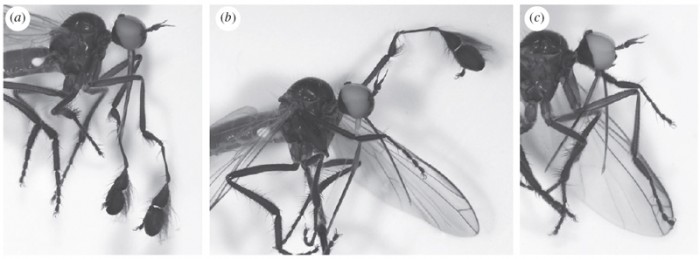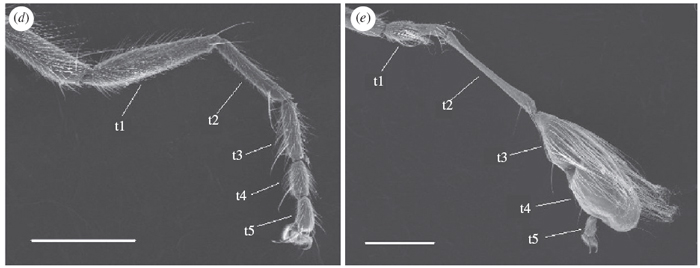Flies are cool. You might even say they’re phat (I know, I’m pretty fly for a white guy). But a newly described dance fly species (Empididae) from Japan takes the term “phat” to an all new level. Meet Empis jaschhoforum:
These are all males, and all representatives of the same species. Talk about intraspecific variation! I’ve encountered rather basic colour differences and some bristle differences in the flies I’ve worked on, but this is pretty ridiculous! What’s intriguing is the asymmetry of the middle specimen. The author’s note that they found asymmetrical males with enlarged left legs, and asymmetrical males with enlarged right legs, showing just how plastic this species is.
But why might these flies display such variance? Empidinine dance fly males can often be found swarming and carrying nuptial gifts (of varying degrees of honesty) to attract females and entice them to mate. These gifts can range from dead insects, dead insects wrapped in silk produced by the front tarsomeres, empty balls of silk, or even look-a-likes such as willow seeds and inflated tarsomeres. Since these specimens were collected in a malaise trap, their natural history isn’t known, so we don’t know which strategy they might utilize, but the variation in forms might provide some clues. It’s not hard to imagine the specimen on the left “faking” a gift with it’s large feet, or exaggerating its gift size with it’s tarsomeres. However, it might be difficult for the male to hold onto a gift and still maintain it’s position in the swarm for any length of time. Imagine wearing mittens and trying to hold a bowling ball while dancing at your favourite bar! The male on the right might be able to hold a gift more tightly and dance more appealingly for longer, but it’s gift may not seem as large to interested females. That’s where the middle man comes in, possibly getting the benefits of both phenotypes; a tight grip and the illusion of a better gift! This is only one hypothesis of course, making further field observations necessary.
Proceedings of the Royal Society B was on an entomological role this week and featured another cool paper, this time on butterfly dispersal across Beringia and how new molecular data may corroborate old ideas on speciation. The significance? Those ideas were put forward by renowned novelist Vladimir Nabokov, whose “lesser” works include Lolita and Pale Fire. Turns out he truly wanted to be a lepidologist and the writing gig was just a means to pay the bills while he collected and described his butterflies! The New York Times has published an excellent account on Nabokov, his controversial theories of species dispersal & evolution, and how this new paper fits into the puzzle. It’s a great piece and well worth a read, plus they share one of the coolest poems I’ve read, also by Nabokov;
On Discovering a Butterfly by Vladimir Nabokov (1943)
I found it and named it, being versed
in taxonomic Latin; thus became
godfather to an insect and its first
describer – and I want no other fame.
Awesome, and quite a fitting end to the 100th post here at Biodiversity in Focus!
References:
Daugeron, C., A. Plant, I. Winkler, A. Stark and M. Baylac “Extreme male leg polymorphic asymmetry in a new empidine dance fly (Diptera: Empididae).” Biology Letters 7(1): 11-14. Open Access
Vila, R., C. D. Bell, R. Macniven, B. Goldman-Huertas, R. H. Ree, C. R. Marshall, Z. Bálint, K. Johnson, D. Benyamini and N. E. Pierce “Phylogeny and palaeoecology of Polyommatus blue butterflies show Beringia was a climate-regulated gateway to the New World.” Proceedings of the Royal Society B: Biological Sciences. Open Access



Full poem: http://feltarbeidferdaminne.blogspot.com/2011/01/to-name-butterfly.html
Even better! Thanks Gunnar
Wow. Flies are such tricksters! Thanks for sharing this info!
Congrats on 100 posts!
Thanks Ted!